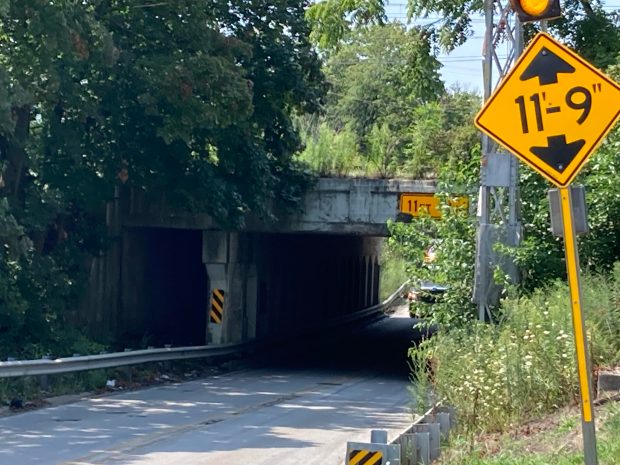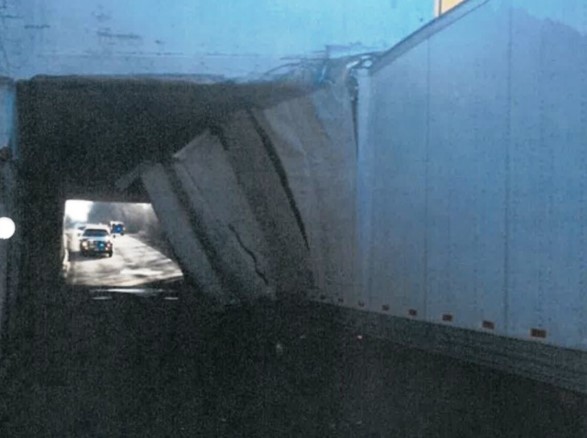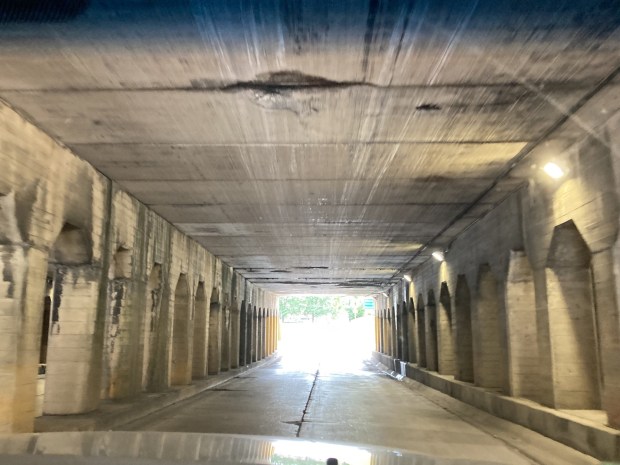Whether it’s a heavy downpour or some other reason, blocked road viaducts can mean problems for drivers on their way to jobs or running errands in the south suburbs.
In some instances, the temporary closures hit main access points in a community, but any sure fixes are slow in coming.
Flooding trouble spots are many. Point to a viaduct for a railroad and odds are a heavy downpour can make traffic impassable.
For drivers in and around Flossmoor and Olympia Fields, a different problem affecting a main east-west roadway involves large trucks trying to pass through a hole too narrow for them to navigate.
A long-term fix has been sought by residents and included in plans by Cook County as part of its long-range transportation improvement initiative.
A frequent problem crops up during storms in Homewood, in a viaduct on Dixie Highway near the village’s downtown.
“It closes probably half a dozen times a year,” Mayor Rich Hofeld said.
How long the water hangs around depends on the intensity of the storm, and Dixie is maintained by the Illinois Department of Transportation, which is aware of the problem and has promised a fix, Hofeld said.
Another viaduct nearby, on 183rd Street, is normally clear after a rain because pumps help keep it open, Hofeld said.
Between Matteson and Richton Park, flooding can get so bad on a viaduct on Governors Highway that gates were installed from both approaches to prevent vehicles from continuing through and stalling out.
A view inside the viaduct at Dixie Highway in Homewood under the Canadian National Railroad tracks. The viaduct often floods after large rains. (Paul Eisenberg / Daily Southtown
In designing and building flood-control projects, the Metropolitan Water Reclamation District has been accounting for Chicago area storms that are more frequent and intense than in years past.
In announcing $20 million in stormwater projects in late June, the district said the projects are focused on bringing flooding relief to underserved communities, including those in the south suburbs.
District and municipal officials said projects being funded include Burbank, Crestwood, Dixmoor, Dolton, Glenwood, Harvey and Midlothian.
The projects are part of a broader goal to “better manage future stormwater and the unpredictable and unsettling nature of climate change,” the district said.
“Climate change will only exacerbate flooding across the county. This is especially true in communities with historic disinvestment which were disproportionately impacted by COVID-19,” Toni Preckwinkle, Cook County board president, said in announcing the funding.
According to the National Weather Service in Chicago, on Sept. 7, 2023, some south suburbs were inundated with 5 inches to more than 6 inches of rain in some isolated areas in and around Calumet City.
The slow-moving system poured more than 4 inches of rain in Oak Forest, and other suburbs, including Hazel Crest and Markham, saw significant rainfall, according to the service.
The September deluge had followed a significant storm system that affected the Chicago area in early July 2023, with led to traffic detours including a temporary closure of Interstate 55 near Pulaski Avenue.
Another major rainstorm in the Chicago area in early July of this year brought significant flooding to near west suburbs such as Cicero and Oak Park, although some southwest suburbs saw rainfall totals of around 2 inches.
Flossmoor Mayor Michelle Nelson said the problem with stuck trucks on Vollmer Road has been high on the priority list, at least as far as her community and neighboring Olympia Fields are concerned.
Between Kedzie and Western avenues, Vollmer runs under a viaduct that carries Metra and Canadian National Railway trains.
Nelson said it’s the angle of the roadway from both east and west that makes a difference, although the viaduct clearance won’t handle larger trucks.
The 11-feet, 9-inch clearance of the Vollmer Road viaduct isn’t compatible considering most tractor-trailer trucks are more than 13-feet tall.

“When you are going at an angle you have a little less clearance,” Nelson said. “Trucks are told to avoid it and not go through it.”
Nelson said she believed police calls for stuck trucks happen perhaps monthly. A message left with Flossmoor police for statistics on closures was not returned.
A recent closure occurred Aug. 16, with Vollmer closed to traffic after a semi-truck struck the viaduct.
Trucks jammed under the viaduct can tie up village services in both Flossmoor and Olympia Fields.
If a truck is heading east on Vollmer, say from Interstate 57, and gets stuck trying to pass, Olympia Fields police respond. For westbound trucks, it is Flossmoor that cleans up the mess.
To avoid big traffic tie-ups, police from both villages coordinate to reroute traffic from the approaches at Western and Kedzie, Nelson said. For her community, that can also divert more traffic onto Flossmoor Road, another east-west route.
Because Vollmer is maintained by Cook County, it would be up to the county working with rail carriers that use the bridge to correct the problem.
Under its long-term transportation improvement plan, Connecting Cook County, the county said it is working with Olympia Fields, with funding from the federal Surface Transportation Program, on preliminary engineering work to rebuild the Vollmer Road corridor in the stretch that passes under the rail tracks.
A spokeswoman for the county was unable to provide an update on that project’s progress.
SHARPwatch, a 25-year-old community action group in Olympia Fields, obtained police reports that showed nearly 60 instances of large trucks striking the viaduct over a period of four years.

Stuck trucks not only disrupt traffic, but can endanger the life and safety of residents as emergency vehicles move from east or west, including ambulances headed to Franciscan Health Hospital in Olympia Fields, says SHARP.
The organization proposed the section of Vollmer between Kedzie Avenue in Olympia Fields and Western Avenue in Flossmoor be redesigned and made off limits to large trucks.
Eugene Broyls, SHARP’s president, said the organization has reached out to numerous agencies and officials trying to move the needle on the project.
“People in Olympia Fields have been fighting for decades to get that designated a no-trucks route,” he said.
Broyls said the SHARP group has made a difference.
The organization said in looking over police reports from some truck vs viaduct crashes, drivers told police their GPS navigation systems or Google Maps indicated Vollmer as a truck route.
FedEx, the freight and parcel carrier, is telling drivers to not use Vollmer, at the request of SHARP, although Broyls said he would like to see other trucking companies post similar advisories for drivers, perhaps at area truck stops.
Broyls said noticed trucks approaching the viaduct from the west tend to turn at Kedzie and find an alternate route.
He said he believes any real solution is in the hands of government agencies with the ability to engineer and, more importantly, pay for a project of that size.
“We were at the point where SHARP had done all they could to make it safer for the public,” he said.
Broyls said a truck smacking into the bridge can be hazardous to drivers in the immediate vicinity.
“When these trucks strike that bridge the amount of debris that flies everywhere can be very dangerous,” he said, citing one driver who had a chunk of truck pierce her vehicle’s windshield.
Broyls also said that SHARP was concerned about the impact of trucks on the viaduct, possibility affecting the concrete and steel structure itself.
Metra said that the viaduct is inspected monthly.
SHARP is an acronym for See, Hear And Report to Police, from its origins as a neighborhood watch group.
Broyls, 89, who has lived in Olympia Fields 30 years, said “we are more an advocate than a community watch group.”
“I had changed it really from ‘Police’ to ‘Problems’ because we’re looking out for all sorts of issues,” he said.




